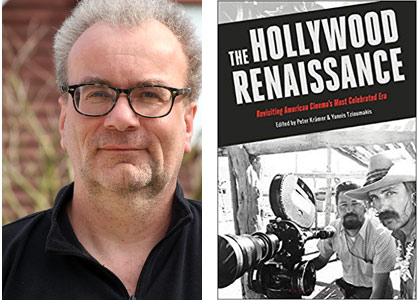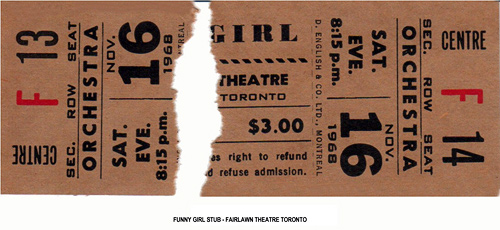The popular musical recently turned fifty, and for the occasion The Bits features a Q&A with a trio of film historians who reflect on the film’s appeal and legacy.
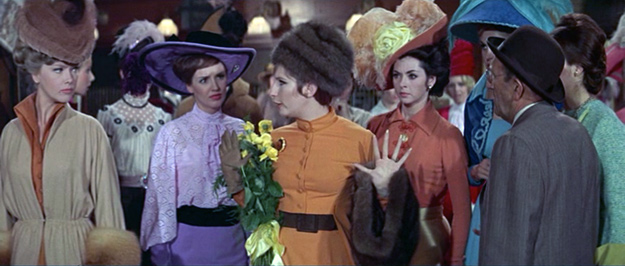
FUNNY GIRL NUMBER$
- 1 = Number of Academy Awards
- 1 = Rank among Columbia’s all-time top-earning movies at close of original release
- 1 = Rank among top-earning films with Streisand in a lead role (adjusted for inflation)
- 2 = Number of markets showing the movie during opening weekend
- 2 = Rank among top-earning films of 1968 (retroactive / legacy / lifetime earnings)
- 2 = Rank among top-earning films of 1969 (calendar year)
- 5 = Number of years Columbia’s top-earning film
- 5 = Rank among top-earning 1960s musicals
- 8 = Number of Academy Award nominations
- 11 = Rank among top-earning movies of the 1960s (earnings from 1/1/60 - 12/31/70)
- 15 = Peak all-time box-office chart position
- 16 = Rank on AFI’s list of Greatest Movie Musicals
- 72 = Number of weeks of longest-running engagement
- $14.1 million = Production cost
- $16.5 million = Box-office rental through 12/31/69 (% of gross paid to distributor)
- $24.6 million = Box-office rental through 12/31/70
- $24.9 million = Box-office rental through 12/31/71
- $25.6 million = Box-office rental through 12/31/72
- $26.3 million = Box-office rental through 12/31/73
- $52.2 million = Box-office gross
- $101.7 million = Production cost (adjusted for inflation)
- $175.7 million = Box-office rental (adjusted for inflation)
- $357.2 million = Box-office gross (adjusted for inflation)
THE Q&A
Kim R. Holston is the author of Movie Roadshows: A History and Filmography of Reserved-Seat Limited Showings, 1911-1973 (McFarland, 2013). Kim is a part-time librarian in the Multimedia Department of Chester County Library (Exton, PA) and lives in Wilmington, Delaware, with his wife Nancy and a menagerie of pets. He is the author or co-author of several other film and performing arts books, including Science Fiction, Fantasy and Horror Film Sequels, Series and Remakes: An Illustrated Filmography, Volume II (1996-2016) (with Tom Winchester, McFarland, 2018), Naval Gazing: How Revealed Bellybuttons of the 1960s Signaled the End of Movie Cliches Involving Negligees, Men’s Hats and Freshwater Swim Scenes (BearManor Media, 2014), Attila’s Sorceress (New Libri Press, 2014), The Shakespeare Controversy (with Warren Hope; McFarland, 2nd ed., 2009), Susan Hayward: Her Films and Life (McFarland, 2002), Science Fiction, Fantasy and Horror Film Sequels, Series and Remakes: An Illustrated Filmography (with Tom Winchester, McFarland, 1997), Richard Widmark: A Bio-Bibliography (Greenwood Press, 1990), and Starlet (McFarland, 1988).
Matthew Kennedy is the author of Roadshow! The Fall of Film Musicals in the 1960s (Oxford University Press, 2014). Matthew is a writer, film historian, and anthropologist living in Oakland. His other books include Joan Blondell: A Life between Takes (University Press of Mississippi, 2007), Edmund Goulding’s Dark Victory: Hollywood’s Genius Bad Boy (University of Wisconsin Press, 2004), and Marie Dressler: A Biography (McFarland, 1999). His articles have appeared in the program books of the San Francisco Silent Film Festival and Turner Classic Movies Classic Film Festival. He is film and book critic for the respected Bright Lights Film Journal and has hosted retrospectives based on his books at the Pacific Film Archive, UCLA Film Archive, and the Museum of Modern Art.
Peter Krämer is the editor (with Yannis Tzioumakis) of The Hollywood Renaissance: Revisiting American Cinema’s Most Celebrated Era (Bloomsbury Academic, 2018). Peter is the author and/or editor of several additional academic books, including a BFI Film Classics volume on 2001: A Space Odyssey (2010), The New Hollywood: From Bonnie and Clyde to Star Wars (Wallflower, 2006), and American Graffiti: George Lucas, the New Hollywood and the Baby Boom Generation (forthcoming from Routledge). He is a Senior Fellow in the School of Art, Media and American Studies at the University of East Anglia in Norwich (UK).
The interviews were conducted separately and have been edited into a “roundtable” conversation format.
Michael Coate (The Digital Bits): How do you think Funny Girl should be remembered on its golden anniversary?
Kim R. Holston: As the film that made Barbra Streisand a star.
Matthew Kennedy: Funny Girl was, is, and forever should be remembered as Barbra Streisand’s film debut. By the time this film appeared in 1968, she had conquered Broadway in the stage version of Funny Girl, was an established recording star, and had performed in top-rated TV specials. Movie stardom might have seemed inevitable, but would her unconventional looks translate on the big screen? The results dazzled and exceeded already high expectations. The film has merits beyond her performance, but they take a backseat to her.
Peter Krämer: As arguably the most amazing movie debut by any performer ever: Barbra Streisand combines rapid fire comic delivery, slapstick comedy, numerous costume changes, melodramatic acting and that amazing singing voice into something quite incomparable.
As an incredibly moving biopic in which the lead actress does not only bring a legendary Jewish performer (Fanny Brice) back to life, but also tells her own story about becoming “the greatest star” against all the odds. Indeed, by the time she appeared in the movie version of her Broadway hit Funny Girl, Streisand’s amazing success as a theatre and concert performer, as a recording artist and television personality had already made her, at the young age of 26, the biggest star in American entertainment, not only of the 1960s but quite possibly of all time.
As the beginning of an unprecedented film career, which saw Streisand appear in an almost unbroken string of hits until 1979 (while her success in other media continued as well). Her track record at the box office during this period far exceeded that of all other female movie stars then or later, and was the equal of any male star at a time when women were more marginalized in Hollywood than ever before or since.
Coate: What do you remember about the first time you saw Funny Girl?
Holston: The first time I saw it I did not care for it. It seemed archaic. Remember, it was 1968 and the world had changed dramatically (Vietnam War, civil rights marches, political assassinations). Funny Girl looks better in retrospect, perhaps because it represents one of the last good roadshow musicals. Watching the DVD version, which features an Overture, Entr’acte and Exit Music, I waxed nostalgic. Something jarring I noticed while watching this and the same year’s other giant musical, Star!, with Julie Andrews and was perhaps why I didn’t like it in 1968 were the close-ups during the stage production numbers. It was unrealistic. No audience member without opera glasses could home in on the performers like this. Upon reflection, I realized that this sort of camerawork did occur in such classic Hollywood “stage” musicals as 42nd Street and Alexander’s Ragtime Band. Perhaps it was the era of the 60s. “Realism” was in.
Kennedy: I saw Funny Girl at the Showcase, the one fancy first run theater in my hometown of Redding, California. I remember being excited during the opening credits, a kind of big city big show excitement not often available in Redding. And then there she was — this giantess demanding not only our attention, but also our awe and supplication.
I remember media obsession over her looks, specifically her large nose. Will she or won’t she have it reduced? It’s easy to forget what an exceptionally special and odd creature she was on first sight. She wholly embraced her singular place in show business. It worked brilliantly for her. It was as though society was congratulating itself on prizing a woman of such rare talent who redefined beauty.
Krämer: I was doing some research in various archives in Los Angeles, and so as to reward myself for a hard day’s work I thought I might go and see an old musical on the big screen. When I arrived at the cinema I was surprised that the audience consisted almost exclusively of men — and many of them were holding hands or showing each other affection in other ways. Now, I had vaguely been aware of the fact that Streisand was a gay icon, but I had not previously attached any particular meaning to this. But then we all sat down, and when the story finally started (after a long credit sequence — I can’t remember now whether they also played the overture), we followed Streisand, who had her back to the camera, walking through the stage door of the theatre and along various corridors until she came to a tall mirror. Now she finally turned so that her face — with that grand nose of hers — could be seen in the mirror, and she addressed that image: “Hello, Gorgeous.” At this point the auditorium erupted into applause and cheering. And I suddenly understood a little bit about what made her a gay icon. She was different (as the rest of the film makes clear, she — like Fanny Brice — was considered ugly by the standards of beauty of the time, she was too Jewish) — and yet she was able to accept herself just the way she was. Or so it seemed.
Coate: In what way is Funny Girl a significant motion picture?
Holston: It was a star-making turn for Barbra Streisand, who joined a select team of actresses who were stars from their first time on screen, e.g., Katharine Hepburn, Doris Day.
Kennedy: Funny Girl was directed by William Wyler, arguably the greatest director of the studio era. It came along after his heyday, and the commonly heard story is Streisand dominated the set, despite Wyler’s veteran experience. But I wonder — is that representative of sexism, or did she exert influence beyond her domain as a vastly talented, disciplined, and ambitious screen newcomer?
The score is excellent. Broadway Songwriter Jule Styne had a fabled career as composer of Gentlemen Prefer Blondes, Bells are Ringing, and the oft-revived much loved Gypsy, all before Funny Girl premiered in 1964. Here we get Second Hand Rose, My Man, and the hit single People, along with several other worthy tunes.
The film not only preserves and glorifies Streisand’s original stage performance, but also Kay Medford’s playing Brice’s mother.
Funny Girl is also a strong example of how to translate a stage production into cinema. Don’t Rain on My Parade gets opened up to take in lower Manhattan, a train, a boat, and Streisand’s thundering proclamation of a self-guided destiny. Wyler employs those wonderful things unique to cinema — the ability to change perspective and distance with each camera set-up. So while the stage audience thrilled to Streisand live, the film audience sees and hears her in close-up, medium, and far shots, with the camera guiding us and contributing greatly to the emotions of the story. Very often Wyler recreates the stage experience as well, with many scenes of Brice rehearsing or before a live audience. But unlike live theater, we get close enough to see tears welling in her eyes.
Krämer: People often forget that, with the exception of the late 1920s and very early 1930s, Hollywood — an industry pretty much founded and largely run by Jewish-Americans — had always been very cautious about coming across very Jewish. So many actors changed their names — and indeed their looks (through cosmetic surgery). p>
Then in 1967 and 1968 everything changed (at least for a while). Streisand (no name change for her — except for dropping that second “a” in her first name), as mentioned earlier the biggest star in American entertainment, makes her debut in a film about a Jewish performer succeeding against all the odds. And the biggest surprise hit in all of Hollywood history, The Graduate, released late in 1967, but dominating the box office all through 1968, has Dustin Hoffman (no name change here either) appearing in the role of a WASP jock. Several commentator at the time noted that this was a bit of a (perhaps subversive) mismatch.
From then onwards, for about a decade, many of the key performers and the most iconic characters in Hollywood movies were ethnic Americans (mostly Jewish-American or Italian-American). Just think about Don Corleone and Al Pacino.
So, together with The Graduate, Funny Girl marks a real turning point in Hollywood history.
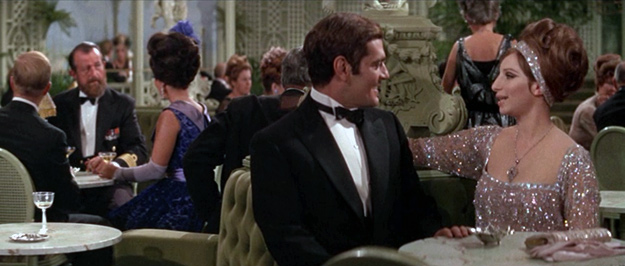

Coate: Can you discuss the casting of Streisand and Sharif in the lead roles?
Holston: Perhaps most noticeably with the final number, My Man, which can be watched over and over again, Streisand could sing up a storm and had no trouble at all being funny. Sharif was suitably handsome.
Kennedy: In Funny Girl, Streisand found a vehicle perfectly suited not only to her gifts as an actress and singer, but as an introduction to her as an instant movie star. She is less than ideal as any facsimile recreation of Fanny Brice, who excelled on stage, screen, and radio, but was never a star of Streisand’s rank. But does that matter to most anyone watching? The story of a poor and plain Jewish girl from the Lower East Side rising to headliner of the Ziegfeld Follies, and suffering heartache in her private life, might as well have been fiction.
Omar Sharif, as heartthrob gambler-swindler husband Nicky Arnstein, does not register as strongly as Streisand. Once I looked away from her blinding light and concentrated on him, however, I saw effective acting. It’s no stretch to see why Brice would fall so thoroughly for him. Hiding behind his great male beauty is tenderness, danger, and self-destruction. Under Wyler’s guidance, Sharif delivers it all.
Krämer: Once Streisand was cast as Fanny Brice for the stage version of Funny Girl, which became a huge success on Broadway, it seemed a foregone conclusion that she would also appear in the movie adaptation. And yet, Hollywood was wary to cast an actress who had never before appeared in a movie in such an expensive production. Also, there were continuing concerns about her looks. A lot of people acknowledged that, despite being declared ugly and being told on numerous occasions to get a nose job, Streisand had somehow managed to come across as beautiful to so many people, that she represented a new kind of beauty. But how could this work when her face was blown up on a huge movie screen? At the same time, her success as a performer on stage, records and television was so massive that she could not really be ignored either. And of course she was absolutely perfect for the role because, to a large extent, the story of Fanny Brice was her own story.
The casting of Omar Sharif, on the back of the success of Doctor Zhivago, created a number of problems. For one thing, he was an Egyptian playing an American Jew. For another thing, Egypt (as well as other Arab countries) and Israel went to war in 1967. For a while, it looked like he might have to be replaced, but then the war was quickly concluded and some people said that, in any case, Streisand and Sharif appearing together was a kind of gesture of peace, or something like that. I haven’t come across any negative comments about his non-Jewish background in the film’s reception.

Coate: How do you think the stage production and sequel compare to the ’68 movie?
Holston: Haven’t seen the stage production or Funny Lady.
Kennedy: I’ve never seen Funny Girl on stage, but I found 1975’s Funny Lady to miss the mark. It has a self-consciousness that plagues so many sequels. There’s a caution to it, and referencing of Funny Girl, rather than making something new and exciting. I don’t like Streisand in Funny Lady half as much as I do in Funny Girl. She became imperious and self-righteous, and I don’t know if that was her evolution as an actress, human being, and/or her interpretation of an older, wiser, angrier Brice. The title becomes a misnomer; she’s not funny anymore. But Streisand is in fine voice and well served with the songs How Lucky Can You Get? and Isn’t This Better.
Krämer: By all accounts, the stage production was constantly evolving, not least because Streisand gradually took control. So it is not easy to compare the film to “the” stage production. What is interesting, though, is that it was widely reported at the time — and confirmed by later reminiscences — that Streisand was battling veteran Hollywood director William Wyler and the rest of the production team for control of the movie as well. And she often seems to have gotten her way.
Compared to my fascination with Funny Girl, I feel rather lackluster about the sequel Funny Lady. It was a considerable hit at the box office. But I don’ think it was particularly special.
Coate: Where do you think Funny Girl ranks among roadshow musicals?
Holston: Funny Girl ranks in the upper echelon of roadshow musicals, of which there were about two dozen between 1955 (Oklahoma!) and 1972 (Man of La Mancha). In contrast to some, which had great scores but lacked pizzazz or had cheap sets (Finian’s Rainbow), it is one of the fully-realized entries. Ahead of it would be West Side Story, The Sound of Music, Oliver!, My Fair Lady, and Gigi. (Note that those movies were in the “naturalistic” mode, i.e., spontaneous singing and dancing, not stage musicals.)
Kennedy: Funny Girl is pretty high on the list of excellent roadshow musicals. It suffers from a sluggish second half and some costume and hair choices too reminiscent of 1968, rather than Brice’s era of the ’30s and ’40s. Despite the all-consuming presence of Streisand, it has other assets. There’s an elder Walter Pidgeon playing an exasperated Flo Ziegfeld. There is everywhere the evidence of a loving, lavish treatment, effectively opened up so as not to slavishly echo the stage version. It well captures the razzle-dazzle of the big splashy Broadway transfer to film.
Two other highly anticipated roadshow musicals appeared that year: Star! and Oliver! Star! with Julie Andrews was an epic bomb. The box office successes of Oliver! and Funny Girl were contrary to the industry trends that would kill the roadshow by the early 1970s. Oliver! dominated the 1968 Academy Awards, beating fellow Best Picture nominee Funny Girl for the big prize. Funny Girl picked up one award — for Barbra Streisand as Best Actress. In a rare tie, she shared the honor with Katharine Hepburn for The Lion in Winter.
Krämer: I am not a great connoisseur of roadshow musicals. I have seen quite a few but I don’t have much of a personal investment in most of them. But Funny Girl means a lot to me.

Coate: What is the legacy of Funny Girl?
Holston: The legacy of Funny Girl is as a prime example of the musical roadshow, which had not long to go.
Kennedy: A good part of Funny Girl’s legacy and value is as a recreation of Streisand’s one-for-the-ages turn in the stage version, now preserved as long as we can watch movies. As a double whammy, it also captures the moment her movie stardom was born. From Funny Girl came these many years of songs, movies, and concerts. Streisand sings I’m the Greatest Star early in Funny Girl, with the lyric “but no one knows it.” Not anymore! She’s been laying claim to that assertion for fifty years.
Krämer: Well, I would say that, to some extent, Funny Girl, together with The Graduate paved the way for ethnic diversity, not at the margins of Hollywood, but at its very center, in its most successful and most highly acclaimed films — at least for a decade or so.
There is also something very resonant about the almost mythical stardom Barbra Streisand has achieved, and this film offers us one version of the story of her rise to fame. Her version of A Star is Born would be another. And, of course, the latest version of that particular movie has Ally (Lady Gaga) talking about the fact that she does not want to perform her songs because “almost every single person that I have come in contact with in the music industry has told me that my nose is too big and that I won’t make it.” This takes us right back to the opening scenes of Funny Girl, when, in the If a Girl Isn’t Pretty number, a teenage Fanny Brice is told the same thing by her mother’s friends, and her mother responds with the immortal lines: “Is a nose with deviation / such a crime against the nation?”
Coate: Thank you — Kim, Matthew, and Peter — for sharing your thoughts about Funny Girl on the occasion of its 50th anniversary.
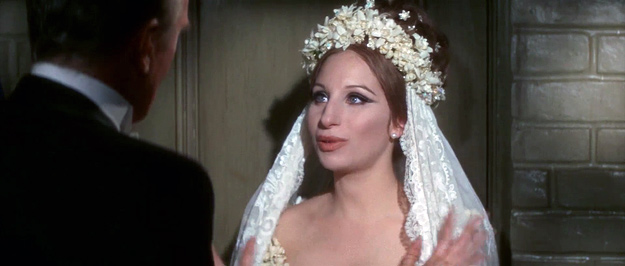
IMAGES
The primary references for this project were regional newspaper coverage and trade reports published in Boxoffice, The Hollywood Reporter and Variety. All figures and data included in this article pertain to the United States and Canada except where stated otherwise.
IMAGES
Selected images copyright/courtesy Columbia Pictures, Sony Pictures Home Entertainment. Roadshow ticket stubs and program from the collection of Robert Morrow.
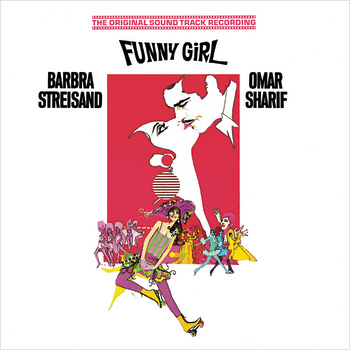
IN MEMORIAM
- Gerald Mohr (“Branca”), 1914-1968
- Harry Stradling (Director of Photography), 1901-1970
- Isobel Lennart (Screenwriter), 1915-1971
- William Kiernan (Set Decorator), 1908-1973
- Robert Luthardt (Art Director), 1917-1977
- Kay Medford (“Rose Brice”), 1919-1980
- William Wyler (Director), 1902-1981
- Walter Pidgeon (“Florenz Ziegfeld”), 1987-1984
- Frank Faylen (“Keeney”), 1905-1985
- John Harmon (“Company Manager”), 1905-1985
- Gene Callahan (Production Designer), 1923-1990
- Irene Sharaff (Costume Designer), 1910-1993
- Jule Styne (Music), 1905-1994
- Gertrude Flynn (“Mrs. O’Malley”), 1909-1996
- Mae Questel (“Mrs. Strakosh”), 1908-1998
- Bob Merrill (Music), 1921-1998
- Penny Santon (“Mrs. Meeker”), 1916-1999
- Robert Swink (Editor), 1918-2000
- Walter Scharf (Music), 1910-2003
- Ray Stark (Producer), 1914-2004
- Ben Lane (Makeup Supervisor), 1912-2007
- Maury Winetrobe (Editor), 1922-2008
- Anne Francis (“Georgia James”), 1930-2011
- Omar Sharif (“Nick Arnstein”), 1932-2015
- Michael Coate
Michael Coate can be reached via e-mail through this link. (You can also follow Michael on social media at these links: Twitter and Facebook)




